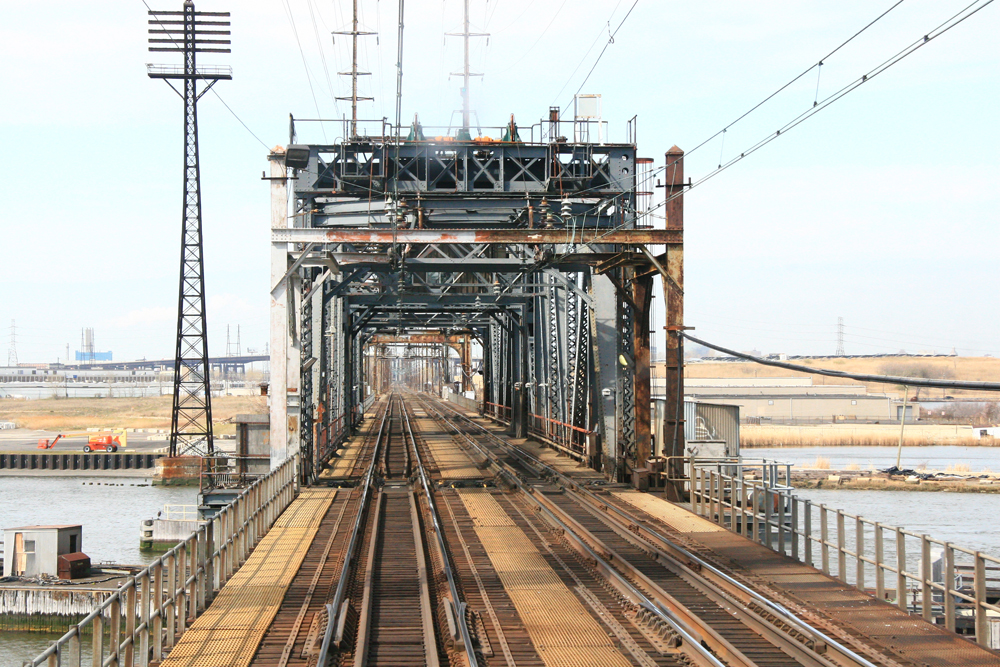
NEW YORK — Amtrak and NJ Transit are experiencing major service issues today as a result of problems that began Thursday at the infamous Portal Bridge in Kearney, N.J.
An Amtrak advisory issued Thursday afternoon says all trains traveling between New York and Newark are experiencing delays because of signal issues at the bridge. All Keystone Service trains, which normally operates between New York and Harrisburg, Pa., via Philadelphia, have been cancelled between Philadelphia and New York, except for two trains today (Friday, May 12), Nos. 642 and 652. Updated information should be available on the Amtrak NEC Alerts Twitter feed, although as of 9:20 a.m. CDT, the newest information there was 14 hours old.
NJ Transit reports its service in and out of Penn Station is operating with “select cancellations” and is subject to 30-minute delays because of the problems at the Portal Bridge, and that Midtown Direct service is being diverted to Hoboken with select cancellations. Tickets and passes are being cross-honored by NJ Transit and private bus operators, as well as PATH trains at Newark Penn Station, Hoboken, and 33rd Street in New York. A list of planned cancellations is available here.
Amtrak spokesman Jason Abrams told NJ.com on Thursday evening that a contractor working in the area of the Portal Bridge “caused an electrical issue affecting critical systems on the bridge that are essential for train movement” and that Amtrak crews were working to solve the issue.
The 112-year-old swing bridge over the Hackensack River has long been an issue for Northeast Corridor operations because it sometimes fails to lock back into place after being opened for marine traffic. The U.S. Coast Guard eventually banned bridge openings during commuter rush-hour periods, which has decreased bridge-related delays [see “Coast Guard to make permanent ban …,” Trains News Wire, Oct. 2, 2019].
Funding is in place and work has begun on a replacement for the bridge, said to be the nation’s busiest [see “Groundbreaking marks start of work …,” News Wire, Aug. 2, 2022]. The new bridge is expected to be ready in 2026.













It never rains, it pours.
In my close look at the picture featured, I noticed something that makes me wonder. Can anyone answer? 1. There are rails to operate the trains on. 2. There are (correct name?) inside rails on bridges to prevent “runaways” from going over the bridge edge. 3. BUT, it seems to me on the main (both) there are retainers however at that point it appears to have “turnout, derail” sections. These are located well in advance of the “main to bridge gap”.
A. Was there a derail system? B. What is the “retainer rails” otherwise named, that is customary on bridge structures? endmrw0513231239
The Portal Bridge has been doing this all my life. Amtrak will eventually get this fixed, as they have many times before. There will be claims against the contractor, and probably counterclaims, probably all with merit. The best news is that, after several generations of futility, a replacement is at last being built.
So work on the new north Portal bridge caused this problem? The quote from Amtrak.
“”Amtrak spokesman Jason Abrams told NJ.com on Thursday evening that a contractor working in the area of the Portal Bridge “caused an electrical issue affecting critical systems on the bridge that are essential for train movement” and that Amtrak crews were working to solve the issue.””
Sounds like an overvoltage or maybe wrong frequency fried one or more signal bungalows. If so, wiring new ones will take time. How long did it take MNRR to replace the one that got damaged?
Thie problem with signals will be an interesting study on how dispatch handles the situation. With just partial Mid town direct service Fr – Sú and none yesterday probably one or more switch tenders needed to route those trains on and off of the NEC. How many signals before the interruption will progressively slow trains is also another metric. Can the dispatchers manually enter each train on their displays the trains traveling thru the dead zone? Imagine our dispatchers have more insight.
I’ll say one thing…Not even close.
Portal Bridge may be 112 years old (original to the line) but you can be sure whatever failed is much newer.
So how does a contractor causing an electrical problem add to the “infamy” of the bridge’s locking issues?